ASM Metals HandBook Vol. 8 - Mechanical Testing and Evaluation
Подождите немного. Документ загружается.

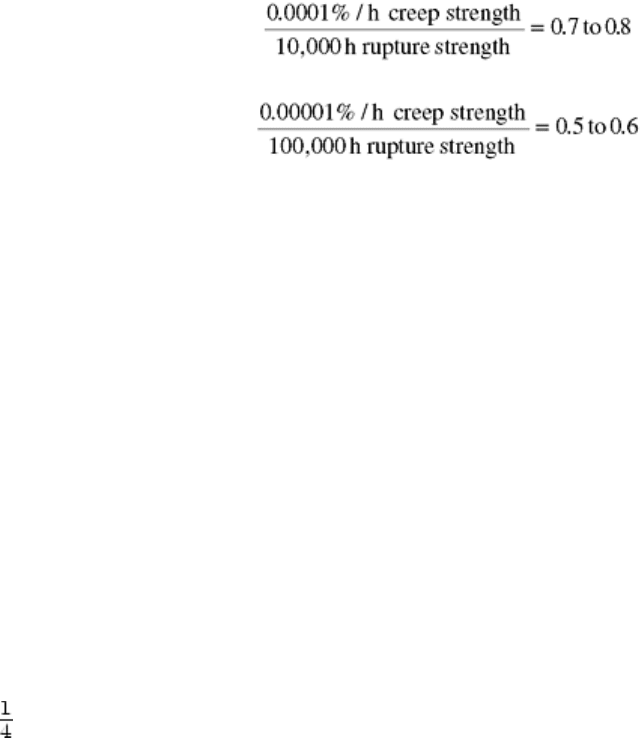
tests on seven heats of type 316 stainless steel. Reannealing of as-received material lowered time to rupture in
some cases, but the degree of variation persisted in properties among heats.
Good linear correlation was obtained when the logarithm of rupture strength was plotted against ultimate tensile
strength at the same temperature for various types of austenitic stainless steels in the annealed and cold-worked
conditions at temperatures ranging from 538 to 816 °C (1000–1500 °F) and for test times approaching 10,000 h.
Tensile strength, in turn, was reported to be essentially proportional to (C + N)d –1/2, where C and N represent
the weight percentage of carbon and nitrogen content, respectively, and d is average grain diameter.
Although long-time performance generally cannot be accurately predicted from short-time data, the location of
a particular set of rupture data within a published scatter band should agree with the relative tensile strength of
the material being tested in the range of tensile strengths spanned by all heats and product forms. Tests to
measure low rates of secondary creep frequently are terminated after the creep rate appears to have become
reasonably constant. If the test duration had been prolonged substantially, a continued slow decline in creep rate
may have been observed.
A “false” minimum rate may occur in some tests before the classical secondary creep period has been reached.
Observations of many comparative creep and rupture strengths for steels has established the following general
relationships:
If a new set of test results differs from these patterns, verification is suggested before the new results are
accepted.
References cited in this section
2. “Standard Recommended Practice for Conducting Creep, Creep-Rupture, and Stress-Rupture Tests of
Metallic Materials,” E 139, Annual Book of ASTM Standards, Vol 03.01, ASTM, 1984, p 283–297.
3. A.K. Schmieder, Size Effect During Rupture Tests of Unnotched and Notched Specimens of Cr-Mo-V
and Cr-Ni Steels, in Ductility and Toughness Considerations in Elevated Temperature Service,
American Society of Mechanical Engineers, New York, 1978, p 31–48
4. B. Aronsson and A. Hede, Some Observations on the Reproducibility of Creep Rate Determinations, in
High-Temperature Properties of Steel, Iron and Steel Institute, London, 1967, p 41–45
5. D.R. Hayhurst, The Effects of Test Variables on Scatter in High-Temperature Tensile Creep-Rupture
Data, Int. J. Mech. Sci., Vol 16, 1974, p 829–841
6. W. Ruttman, M. Krause, and K.J. Kremer, International Community Tests on Long-Term Behavior of
2- %Cr-1%Mo Steel, in High-Temperature Properties of Steel, Iron and Steel Institute, London, 1967,
p 23–29
7. D. Coutsouradis and D.K. Faurschou, “Cooperative Creep Testing Program,” AGARD Report 581,
North Atlantic Treaty Organization, Advisory Group for Aerospace Research & Development, Neuilly-
sur-Seine, France, 1971
8. “Report on the Elevated-Temperature Properties of Stainless Steels,” DS 5-S1, ASTM, 1965
9. “An Evaluation of the Yield, Tensile, Creep, and Rupture Strengths of Wrought 304, 316, 321, and 347
Stainless Steels at Elevated Temperatures,” DS 5-S2, ASTM, 1969
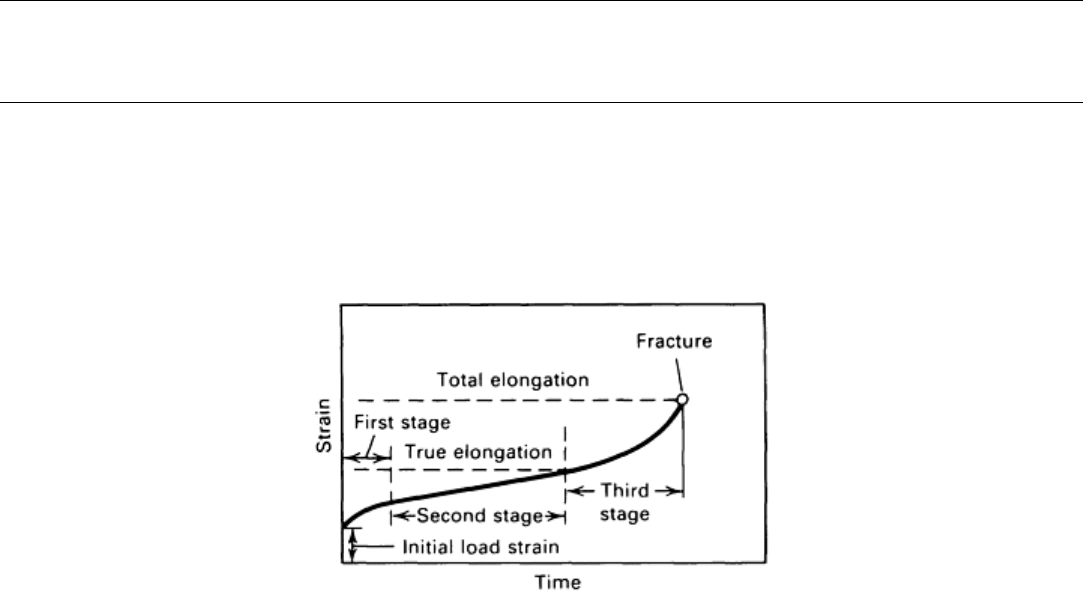
10. “Supplemental Report on the Elevated-Temperature Properties of Chromium-Molybdenum Steels,” DS
6-S1, ASTM, 1966
11. “Supplemental Report on the Elevated-Temperature Properties of Chromium-Molybdenum Steels,” DS
6-S2, ASTM, 1971
12. “Report on the Elevated-Temperature Properties of Selected Super-Alloys,” DS 7-S1, ASTM, 1968
13. “An Evaluation of the Elevated-Temperature Tensile and Creep-Rupture Properties of Wrought Carbon
Steel,” DS 11-S1, ASTM, 1969
14. “Evaluation of the Elevated-Temperature Tensile and Creep-Rupture Properties of C-Mo, Mn-Mo and
Mn-Mo-Ni Steels,” DS 47, ASTM, 1971
15. “Evaluation of the Elevated-Temperature Tensile and Creep-Rupture Properties of Steel,” DS 50,
ASTM, 1973
16. “Evaluation of the Elevated-Temperature Tensile and Creep-Rupture Properties of 3 to 9 Percent Cr-Mo
Steels,” DS 58, ASTM, 1975
17. “Evaluations of the Elevated-Temperature Tensile and Creep-Rupture Properties of 12 to 27 Percent
Chromium Steels,” DS 59, ASTM, 1980
18. “Compilation of Stress-Relaxation Data for Engineering Alloys,” DS 60, ASTM, 1982
19. V.K. Sikka, H.E. McCoy, Jr., M.K. Booker, and C.R. Brinkman, “Heat-to-Heat Variation in Creep
Properties of Types 304 and 316 Stainless Steels,” ASME Paper 75-PVP-26, American Society of
Mechanical Engineers, New York, 1975
Assessment and Use of Creep-Rupture Properties
Howard R. Voorhees, Materials Technology Corporation Martin Prager, Materials Properties Council
Nonclassical Creep Behavior
The curve of creep deformation versus time traditionally displays three consecutive stages (Fig. 1). The longest
period of substantially constant creep rate is preceded by a primary stage during which the rate declines from an
initial high value and is followed by a tertiary stage of rising creep rate as rupture is approached (Fig. 2).
Fig. 1 Schematic tension-creep curve showing the three stages of creep
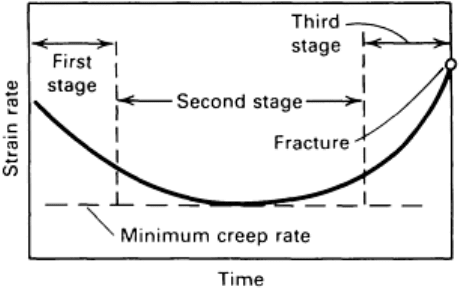
Fig. 2 Relationship of strain rate, or creep rate, and time during a constant-load creep test. The
minimum creep rate is attained during second-stage creep.
Although this classical pattern can be made to fit many materials and test conditions, the relative duration of the
three periods differs widely with materials and conditions. For example, in many superalloys and other
materials in which a strengthening precipitate continues to age at creep temperatures, brief primary creep often
shows transition to a long upward sweep of creep rate, with hardly more than a point of inflection for the
secondary period.
Aging of normalized and tempered 0.5Cr-0.5Mo-0.25V steel during creep under 80 MPa (11.6 ksi) stress at 565
°C (1050 °F) has been reported to cause the creep curve to effectively exhibit only a continuously increasing
creep rate to fracture (Ref 20). For twice the amount of stress, the creep curve in this case followed the classical
trends. In other alloys, such as titanium alloys, with limited elongation before fracture, the tertiary stage may be
brief and may show little increase in creep rate before rupture occurs.
A more obvious departure from classical behavior develops during the early portion of many tests when precise
creep measurements are taken. When 34 ferritic steels were studied for as long as 100,000 h at temperatures
ranging from 450 to 600 °C (842–1112 °F), step-form irregularities were observed, with an extended period of
secondary creep preceded by a lower steady creep rate of shorter duration during primary creep (Ref 21).
Negative Creep. Because a variety of metallurgical processes can be involved and because the rates and
direction of these processes can vary with time and temperature, departures from classical creep curves can take
many forms and can be overlooked unless accurate creep readings are taken at sufficiently close intervals,
particularly during early stages of the test. For 2.25Cr-1Mo, Cr-Ni-Mo, and Cr-Mo-V steels, some tests have
demonstrated an abrupt drop to negative creep rate (contraction) after a brief beginning period of positive
primary creep. Once this contraction ceased, the remaining portion of the test displayed the classical succession
of declining, steady, and then rising creep rates. Figure 3 gives an example for normalized and tempered
2.25Cr-1Mo steel, tested at 275.8 MPa (40 ksi) at 482 °C (900 °F) (Ref 22).

Fig. 3 Creep curve of 2.25Cr-1Mo steel with nonclassical early stage. Normalized and tempered to 607
MPa (88 ksi) tensile strength at room temperature. Tested at 482 °C (900 °F) at 275.8 MPa (40 ksi)
Definite negative creep was noted in at least one test each at 482, 704, 816, and 871 °C (900, 1300, 1500, and
1600 °F) for cast CF8 austenitic stainless steel in tests of boiler and pressure-vessel materials (Ref 22). Rupture
times for these tests ranged from 1000 h to longer than 30,000 h. For some combinations of material lots and
test temperatures, nearly all creep curves of these tests showed an early “false” minimum rate during part of the
primary stage. Structural changes responsible for the measured contraction were undetermined.
Short-term negative creep also was observed in tests on quenched and tempered 2.25Cr-1Mo steel at 482 °C
(900 °F) and at 482 and 538 °C (900 and 1000 °F) for the same steel in the normalized and tempered condition.
Two steady-state creep stages for annealed 2.25Cr-1Mo steel have been reported (Ref 23), which were due to
the interaction of molybdenum and carbon atoms with dislocations and the subsequent decrease in the number
of these atoms as Mo
2
C precipitated. A volume decrease associated with the precipitation process also could
account for the observed creep curve trends.
Interstitial diffusion of carbon and hydrogen into dislocations has been observed, and alloy strain-aging effects
have been found to cause creep rate transitions noted for carbon steels and normalized 0.5% Mo steel (Ref 24).
Negative creep in Nimonic 80A appears related to an ordering reaction in the Ni-Cr matrix and possible
formation of Ni
3
Cr (Ref 25).
Oxide and Nitride Strengthening. An entirely different source of variation from classical patterns occurs in
creep tests at high temperature due to reaction with the air that forms the environment. Tests longer than 50 h
with 80Ni-20Cr alloys at 816 and 982 °C (1500 and 1800 °F) showed a deceleration of creep after the normal
tertiary stage was reached, resulting in a second period of steady-state creep and later another period of last-
stage creep (Ref 26). Figure 4 illustrates a creep curve showing the effect of oxide strengthening.
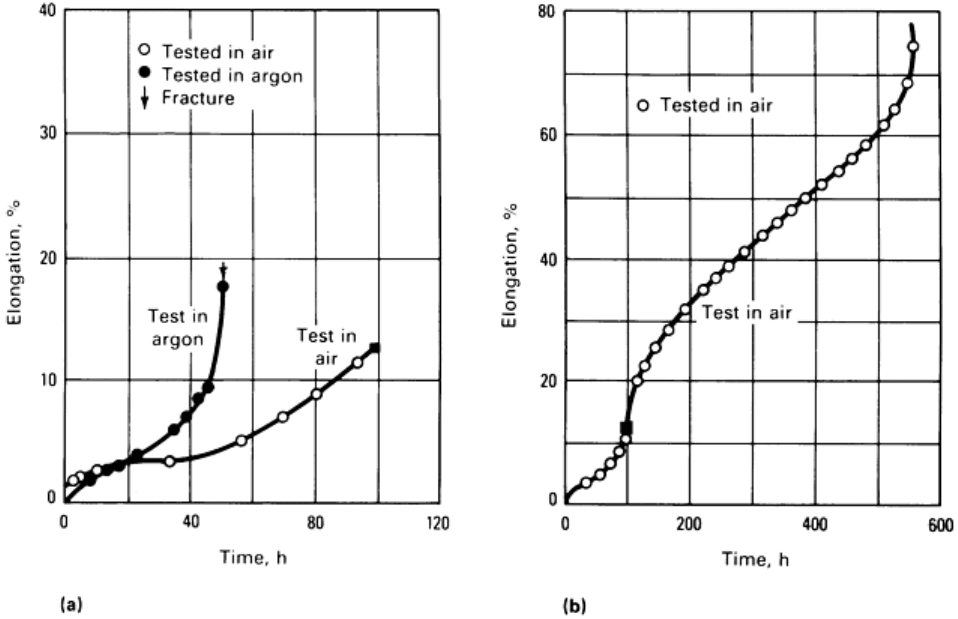
Fig. 4 Creep curves of alloy 2V tested at 980 °C (1800 °F) and 17.2 MPa (2500 psi). (a) Tests in argon
and air for same duration. (b) Entire curve of specimen tested in air is shown. Filled square on both
graphs represents same point.
This behavior, which prolonged rupture life and caused a slope decrease in curves of log stress versus log
rupture life, was due to oxide and nitride formation on surfaces of the intercrystalline cracks that form
extensively during tertiary creep. Observed interconnection of the bulk of these cracks added substantially to
strengthening against creep deformation in the late stages of the tests.
This effect also was observed in 99.8% Ni tested at 815 °C (1500 °F) under 20.7 MPa (3000 psi) stress (Ref
27). Fracture after a prolonged time occurred in a lower stressed section of the fillet. Fewer intergranular cracks
in this region resulted in less oxidation strengthening than in the gage section.
References cited in this section
20. K.R. Williams and B. Wilshire, Effects of Microstructural Instability on the Creep and Fracture
Behavior of Ferritic Steels, Mat. Sci. Eng., Vol 28, 1977, p 289–296
21. M. Wild, Analysis of Creep Behavior of Heat-Resistant Ferritic Steels at Temperatures from 450 to 600
°C, Archiv. Eisenhüttenwes., Vol 34, Dec 1963, p 935–950 (in German)
22. Private business communication, Materials Technology Corporation data sheets submitted to the Metal
Properties Council for tests under MPC Contract No. 174-1
23. R.L. Klueh, Interaction Solid Solution Hardening in 2.25 Cr-1Mo Steel, Mat. Sci. Eng., Vol 35, 1978, p
239–253
24. J. Glen, The Shape of Creep Curves, Trans. ASME J. Basic Eng., Vol 85 (No. 4), Series D, Dec 1963, p
595–600
25. J.P. Milan et al., Negative Creep in Ni-Cr-Ti Alloys, Fourth Interamerican Conference on Materials
Technology, Caracas, June–July 1975, p 102–106
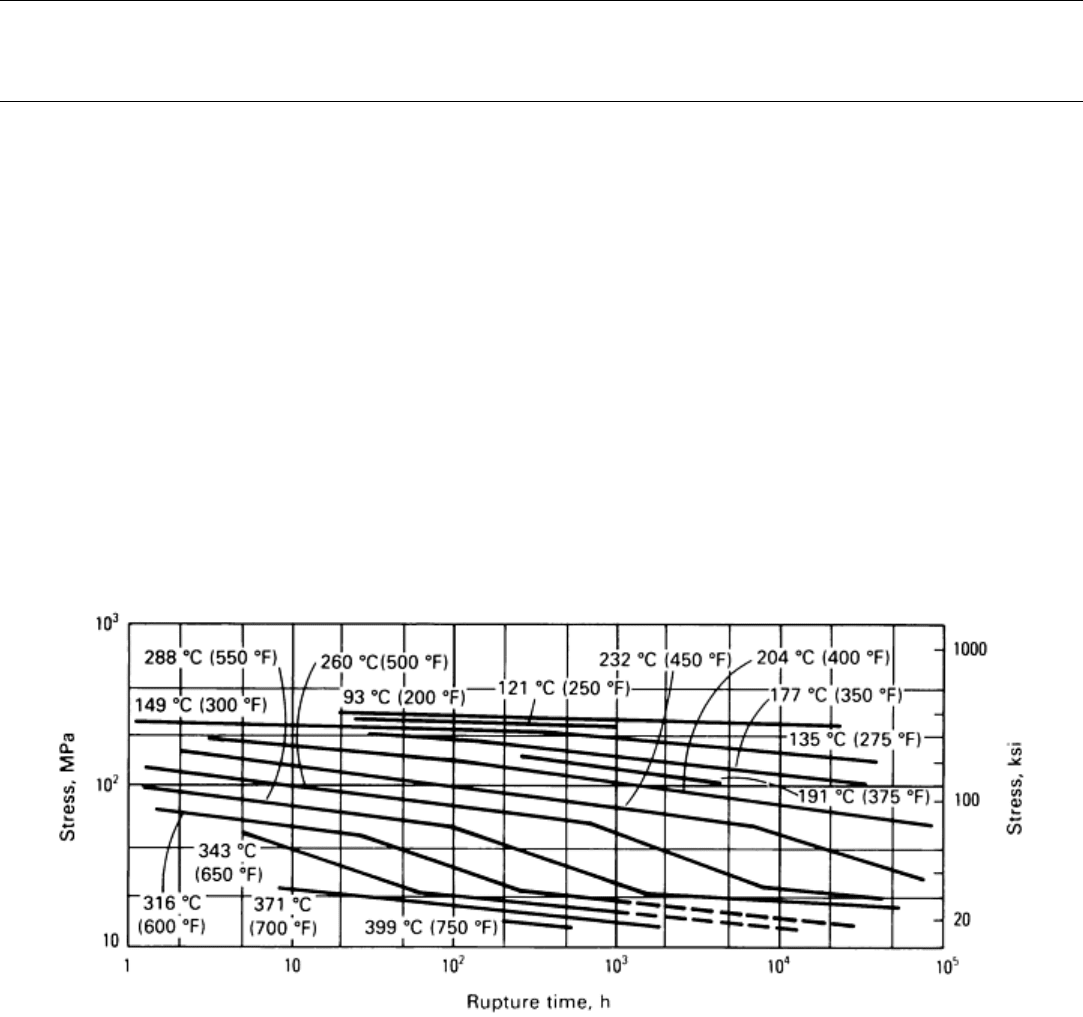
26. R. Widmer and N.J. Grant, The Role of Atmosphere in the Creep-Rupture Behavior of 80Ni-20Cr
Alloys, Trans. ASME J. Basic Eng., Vol 82 (No. 4), Series D, Dec 1960, p 882–886
27. P. Shahinian and M.R. Achter, Creep-Rupture of Nickel of Two Purities in Controlled Environments,
Joint International Conference on Creep, Institute of Mechanical Engineers, London, 1963, p 7-49 to 7-
57
Assessment and Use of Creep-Rupture Properties
Howard R. Voorhees, Materials Technology Corporation Martin Prager, Materials Properties Council
Extrapolation and Interpolation Procedures
The determination of creep-rupture behavior under the conditions of intended service requires extrapolation
and/or interpolation of raw data. No single method for determination of properties exists; rather, various
techniques have evolved for data handling of most materials and applications of engineering interest. These
techniques include graphical methods, time-temperature parameters, and methods used for estimations when
data are sparse or hard to obtain. Recent developments for predicting remaining life of components in creep
service are described in this section.
Graphical Methods
Test results frequently are displayed as plots of log stress versus log rupture time and log stress versus log
secondary creep rate, with a separate curve (isotherm) for each test temperature. For limited ranges of test
variables, test points frequently fall in a straight line for each temperature. Nonlinearity of isotherms with
broader ranges of test parameters has been treated variously, but common practice is to represent the data by
two or more intersecting straight line segments. Figure 5 illustrates such treatment for an aluminum alloy.
Fig. 5 Logarithmic plot of stress versus rupture life for aluminum alloy 6061-T651
Isotherms for lower temperatures characteristically display a flatter slope than those for higher temperatures. At
a given temperature, when the test stresses drop below a given level that varies with alloy composition and
metallurgical condition, the slope of the isotherm usually steepens. This steeper slope often approximates the
slope for early times at the next higher test temperature.
Early investigators of engineering creep behavior introduced a “conservative” practice of using the slope from
the next higher temperature when an isotherm had to be extended to longer times. Use of this method is limited
to the specific temperatures of the test runs. Even under these conditions, extrapolations should be only in the
direction of longer times for the lower range of test temperatures.
Because the change in slope of log stress versus log time isotherms historically appeared to be associated with a
gradual change in fracture mode from transgranular at lower temperatures and higher stress to intergranular at
relatively high temperatures and low stress, the belief developed that once the slope of the longer time portion
became established, further slope change would not occur. Experimental data available at that time provided no
indication that these linear plots could not be extrapolated to long times with confidence. Subsequent long-time
data demonstrate that such extrapolations may lead to erroneous results.
Upward Inflection of Log-Log Rupture Plots at Long Times
Review of 52 heats from 31 wrought and cast steels, each with test times longer than 50,000 h, indicated that
some portion of the log stress versus log rupture time curves for all ferritic steels showed a decrease in slope
when tests were of sufficiently long durations (Ref 28). The degree of this upward inflection depends on
composition, heat treatment, and, particularly, test temperature.
A sharp inflection at one temperature (e.g., 500 °C, or 930 °F) was usually accompanied by a less distinct
inflection covering a broader time range at a higher test temperature (e.g., 550 °C, or 1022 °F). Generally, these
inflections shifted to shorter times and lower stresses with increasing test temperature. Existence of inflections
appeared to be related to precipitation phenomena.
For the heat-treatable aluminum alloy 6061-T651, test stresses between about 20 and 50 MPa (2900 and 7250
psi) for temperatures ranging from 260 to 343 °C (500–650 °F) exhibited nearly the same slope on a plot of log
stress versus log rupture time, which was steeper than for either higher or lower stress levels (Ref 29). The
long-time rupture results obtained had been predicted (Ref 30) by separate graphical extrapolation of each of
three regimes of rather constant slope (see Fig. 5).
In this instance, the curves that were actually extended were lines for fixed stress levels (isostress lines) on plots
of log rupture time versus temperature, or the reciprocal of absolute temperature. However, extrapolation could
have been carried out on the usual log stress versus log rupture time plot by treating the data as a family of
curves, with different portions of each curve falling into different slope regimes. Direct graphical extension of
isostress lines appeared to provide better extrapolation of rupture data than other common methods (Ref 31).
Curves of log stress versus log rupture life for two chromium-molybdenum steels (ASTM A 387, grades 22 and
11) typically show an increase followed by a decrease in steepness for tests at 538 to 566 °C (1000–1050 °F).
Consequently, correct prediction of 100,000 h strengths requires that these changes in slope be incorporated
into the analysis (Ref 32). This requirement applies to all evaluation methods. Unless the input data include
results that encompass structural changes of the type expected under intended service conditions, accurate
extrapolation cannot be expected.
Some metallurgists prefer a semilogarithmic plot of stress versus log rupture time. The sigmoidal shape of
isotherms is thus more evident, but extrapolation difficulties remain. The double inflections (or sigmoidal
shape) for rupture curves can be greatly accentuated when notched specimens are tested. In the intermediate
stress regime, rupture life can actually decrease as the level of test stress is lowered.
Time-Temperature Parameters
Temperatures that are higher than those encountered in service have traditionally been used to shorten the time
required to obtain creep-rupture results. One such approach incorporates time and temperature into an
expression or parameter, such that a single master curve of stress or log stress can represent all data obtained for
a given lot of material over a wide range of test conditions.
When the parameter calculated for a desired service time and temperature falls within the range of the master
curve, the corresponding stress can be read directly from that curve. More than 30 parameters have been
proposed; although not always developed that way, several can be derived from the following:

(Eq 1)
where t is rupture time in hours; σ is stress in psi; T is test temperature in °F; and T
A
, log t
A
, Q, and R are
constants determined from the experimental test data. Geometric requirements for lines of constant stress for
several parametric models are shown in Fig. 6 (Ref 23), a plot of logarithm of time versus either temperature or
its reciprocal. Of these, the Larson-Miller and Manson-Haferd parameters represent early developments in
time-temperature parameters that retain considerable application.
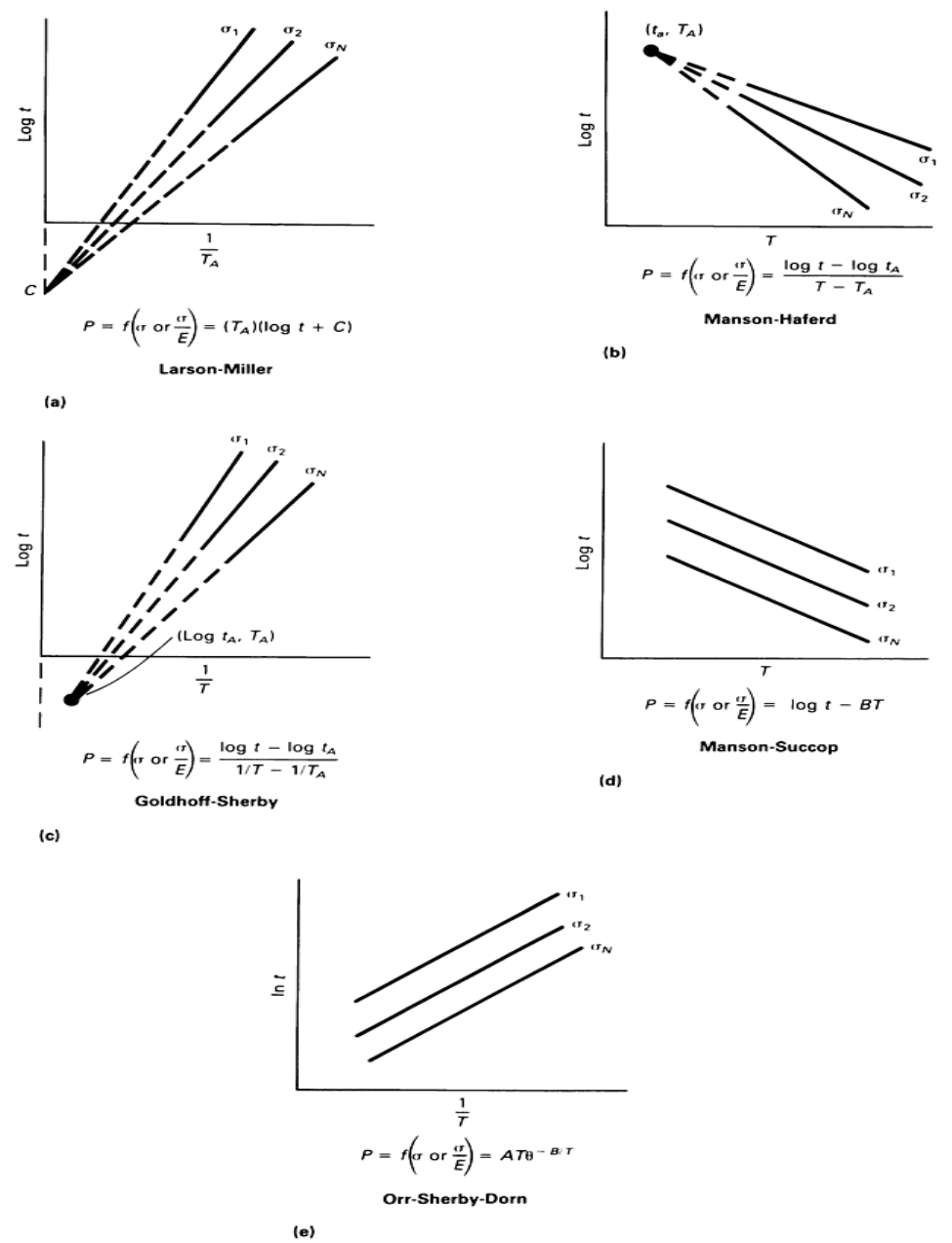
Fig. 6 Schematic representation of several parametric models. In the equations given for each
parameter, σ is applied stress, t is time, T is temperature in °C or °F, T
A
is absolute temperature in K or
°R, Q is the activation energy, R is the gas constant, and B and C are numerical constants characteristic
of the material and its metallurgical condition.
The Larson-Miller Parameter. In 1953, Larson and Miller introduced the concept of time-temperature
parameters to correlate and extrapolate creep-rupture data (Ref 34) for absolute temperature, T
A
, and time to
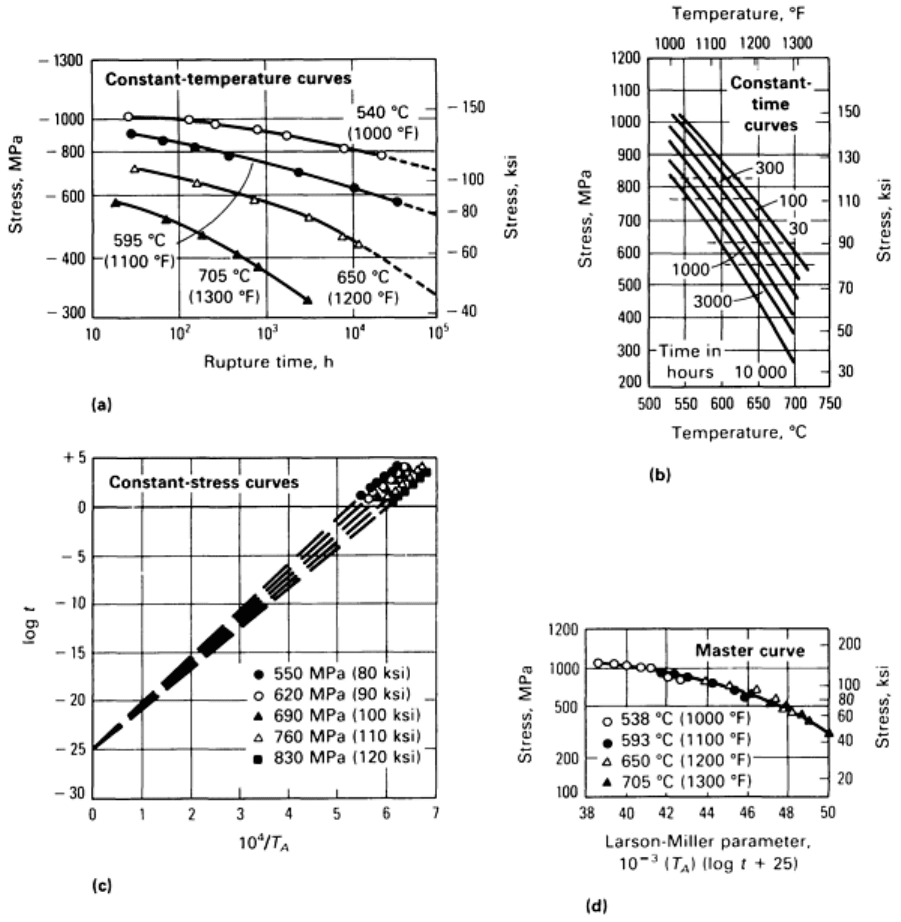
rupture, t
r
. Their parameter P = f(σ) = T
A
(log t
r
+ C) is depicted on a graph of log t or log (t
r
) versus 1/T
A
by
straight constant stress lines converging to a point at 1/T
A
= 0 (Fig. 6a). At that point, log t = C defines the
optimum value of C for the data involved.
In Fig. 7(a), an actual set of stress-rupture data is shown for the nickel-base alloy Inconel 718 as log stress
versus log time to rupture. The data are then replotted as constant-time curves on coordinates of stress versus
temperature in Fig. 7(b). To that graph dashed horizontal lines have been added for stress levels of 550, 620,
760, and 830 MPa (80, 90, 110, and 120 ksi). Values for T at the intercepts of these dashed lines and the
constant-time curves have been read off and plotted in Fig. 7(c) on coordinates of log t versus 10
4
/T
A
. By
extending the data in Fig. 7(c), a plausible set of converging isostress lines meeting on the ordinate at a value of
log t = -25 can be obtained. The Larson-Miller equation for this set of data is:
P = T
A
(log t
r
+ 25)
(Eq 2)
where absolute temperature, T
A
, is in units of the Kelvin or Rankine temperature scales.
Fig. 7 Method of creating master Larson-Miller curve for Inconel 718 from experimental stress-rupture
curves
For each data point in the original set of stress, time, and temperature data, the proper value can be substituted
in Eq 2 and plotted as shown in Fig. 7(d). This is the compact parameter form of graphical representation
known as the “master curve.” A common practice when input data are limited is to assume that C = 20, which
has been found to be reasonably true for many materials.
